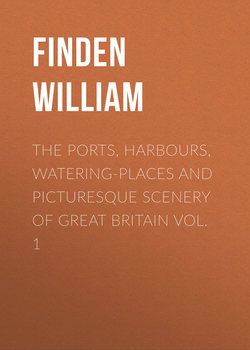Читать книгу The Ports, Harbours, Watering-places and Picturesque Scenery of Great Britain Vol. 1 - Finden William - Страница 10
FLAMBOROUGH HEAD
ОглавлениеThe view of Flamborough Head, drawn by Balmer, is taken from the cliffs to the north-west. To the left is the promontory properly called "The Head," at a short distance from which stands the lighthouse. Between the Head and the nearer cliffs is a small haven, which is used as a landing place by the fishermen of the village of Flamborough, which lies about a mile to the south-west of the lighthouse.
Flamborough Head, which lies about eighteen miles southward of Scarborough, and four and a half miles northward of Burlington, is one of the most remarkable promontories on the eastern coast. It projects about five miles into the sea, from a line drawn between Burlington Quay and Filey; and its southern side forms the northern boundary of Burlington Bay. The cliffs, which are of limestone rock, are from three hundred to four hundred feet high, and their crumbling sides form the haunt and the breeding place of innumerable flocks of sea-birds: among which are cormorants, puffins, razor-bills, and guillemots, with gulls and terns of several species. Guillemots, which are here extremely numerous, are known to the seamen of Shields and Newcastle by the name of "Flamborough-head pilots," as their presence in considerable numbers is almost a certain indication of the ship being "off the Head." Great numbers of those feathered denizens of the cliff are killed every year by "parties of pleasure," from Burlington, Scarborough, and other places, who visit the "Head" for the sake of indulging in the heartless sport, which requires neither skill nor courage, of killing birds by wholesale. At the foot of the cliff, which to the north-west is much indented, there are several caverns and large insulated masses of rock. The largest of those caverns, called Robert Lyth's Hole, has two openings, the one communicating with the land and the other exposed to the sea. The roof, though low at the landward entrance, is in some places fifty feet high; and the view, looking through the rocky vault towards the sea, is extremely grand.
Flamborough Head, which is a most important land-mark for vessels navigating the eastern coast, lies in 54° 8' north latitude; longitude 2' 30" west. A revolving light is displayed from the lighthouse from sunset to sunrise, and presents, first the appearance of two lights on the same tower, and next a brilliant red light. Each of those lights appears at intervals of two minutes; and after gradually attaining their greatest lustre, they in the same manner decline and become eclipsed.
Between Flamborough Head and Burlington Quay, is situated Burlington Bay, a secure roadstead in north-east gales; and, during the prevalence of such winds, it is not unusual for three hundred ships to be riding there at the same time, sheltered from the violence of the wind and sea by the lofty promontory. On the south-east, the Bay is partially sheltered from the violence of the sea by the Smithwick Sands, which run nearly in a line with the coast, from Burlington Quay to Flamborough Head. At each extremity of those sands there is a channel leading into the Bay; that towards the Head is called the North Sea; and the other, towards Burlington, the South Sea. Though the Smithwick Sands effectually break the violence of the sea at low water, yet at high water, when they are covered to a considerable depth, the protection which they afford, in gales of wind from the south-eastward, is not to be depended on. Vessels, therefore, leave the Bay as soon as the wind changes to east or south-east, as it no longer affords them sufficient security; the protection of the Smithwick Sands not being equivalent to the risk of the lee-shore, to which they would be exposed in a gale from the south-east. Were the harbour of Burlington, which is situated to the westward of the Bay, enlarged and deepened, its importance, as a place of refuge for vessels compelled to leave the Bay from the wind changing to the eastward, would be very greatly increased. Could it be so enlarged as to admit one hundred vessels, of from 200 to 300 tons each, it would, with the Bay, afford a place of refuge in all storms from north-east to south-east, which are generally the most destructive on the eastern coast.
